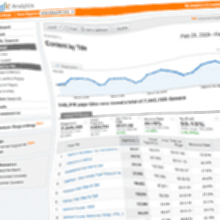How to Sell Statistics to Clients
 There are lies, damn lies, and statistics. Then there are web statistics. Marketing departments love web statistics and they are blatantly used to promote the success of companies and web sites. How many times have you read an article stating that Site X has received Y million hits? It is totally meaningless but few people will ever question the figures.
There are lies, damn lies, and statistics. Then there are web statistics. Marketing departments love web statistics and they are blatantly used to promote the success of companies and web sites. How many times have you read an article stating that Site X has received Y million hits? It is totally meaningless but few people will ever question the figures.
You can provide analytic tools, such as those listed by Rick Tansun, but few clients will understand those applications or the reports they generate. What clients really need is help to make sense of the figures.
Statistical Pitfalls
In my experience, the loudness or frequency of a person’s request for web statistics is inversely proportional to their understanding of them. Confusion often arises because:
1. Statistical terms are misunderstood
Many people equate hits with unique users even though a “hit” is a single file request. One view of this SitePoint page generates more than 50 hits. You can understand why press releases refer to 50,000 hits rather than 1,000 page views or 100 unique users.
2. Statistics are assumed to be accurate
Computers are independent number-crunching machines so reports must be correct? If that were true, the figures generated by different analytic tools would be identical – but they rarely are:
- Different methods of data collection are employed. For example, AWStats analyses web server log files whereas Google Analytics uses client-side JavaScript code.
- No data collection method is perfect. Log files do not contain requests for files cached on the user’s browser or proxy servers. Similarly, people who disable JavaScript are invisible to Google Analytics.
- Each tool makes different assumptions. For example, one system could assume that a single visitor session will time out after 20 minutes of website inactivity. Another might choose 15 minutes or add 5% to figures to account for people with JavaScript disabled.
3. Statistics cannot be gathered retrospectively
Statistics are only as good as the data collected. Clients often ask for information that sounds reasonable, e.g. “how many of my customers are female?”, but it is impossible to determine that figure unless you have captured the appropriate information first.
Statistical Services
Statistics can be offered as a separate service or included as a value-added feature within your website quotations. Typical services that raise your level above competitors include:
1. Cheat sheets
Documents are provided which:
- explain terms such as hits, unique visitors, visits, page views, bounce rates, depth of visit, landing pages, campaigns, goals, etc.
- help the client use and understand the reporting tool.
2. Training and Support
One or two hours training is usually enough to explain web statistics, technical issues, and how the client can make best use of the reporting system. You could also provide ongoing support, refresher courses, or advanced training adapted to the client’s requirements.
3. Summary Reports and Analysis
Whilst statistics may be interesting, what the client really needs is concise, solid marketing information, e.g. product X sells better at the weekend, articles about topic Y receive 50% more visitors, marketing campaign Z resulted in 100 sales. Gathering that information requires technical expertise and could be worth thousands to your client.
These services may be time consuming, but they also provide further opportunities to meet your client and help them increase sales. Your business relationship will grow stronger and, the more successful they become, the more work they will put your way.
Do you sell statistical services? Are you considering it? Are your clients making the most of the information?
Craig is a freelance UK web consultant who built his first page for IE2.0 in 1995. Since that time he's been advocating standards, accessibility, and best-practice HTML5 techniques. He's created enterprise specifications, websites and online applications for companies and organisations including the UK Parliament, the European Parliament, the Department of Energy & Climate Change, Microsoft, and more. He's written more than 1,000 articles for SitePoint and you can find him @craigbuckler.







